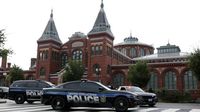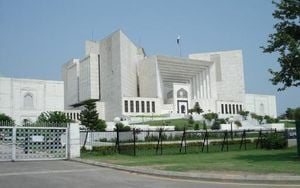On September 5, 2025, a dramatic standoff over the future of one of America’s most cherished cultural institutions reached a new pitch. Four Democratic senators sent a forceful letter to Lonnie G. Bunch, secretary of the Smithsonian Institution, urging him to resist what they described as attempts by the White House to "bully the institution to go against its mission and values." The move came in direct response to recent actions and statements by President Trump and his administration, who have accused the Smithsonian and other museums of promoting a negative view of American history—a claim that has ignited fierce debate in Washington and beyond.
The letter, coauthored by Senators Alex Padilla (D-Calif.), Catherine Cortez Masto (D-Nev.), Gary Peters (D-Mich.), and Jeffrey A. Merkley (D-Ore.), was prompted by a series of escalating criticisms from President Trump. According to NPR, Trump had recently labeled the Smithsonian and museums “the last remaining segment of 'WOKE'” and argued on Truth Social that their exhibitions focus too much on "how horrible our Country is, how bad Slavery was, and how unaccomplished the downtrodden have been — Nothing about Success, nothing about Brightness, nothing about the Future."
These statements were soon followed by an unsigned White House memo, released in August, titled "President Trump Is Right About The Smithsonian." The document specifically criticized 22 exhibitions and programs at the Smithsonian, accusing them of promoting divisive or partisan narratives. However, as BERITAJA and NPR both reported, some of the criticized exhibitions were temporary and are no longer on display, raising questions about the accuracy and intent behind the memo.
At the heart of the dispute is the Trump administration’s announcement that it will audit exhibitions and holdings at eight Smithsonian museums, including the National Museum of African American History and Culture and the National Museum of American History. The stated goal: to ensure these institutions align with the President’s directive to "celebrate American exceptionalism, remove divisive or partisan narratives, and restore confidence in our shared cultural institutions." Trump himself vowed on social media to "start with the Smithsonian and go from there," signaling a broader campaign to reshape the nation’s approach to its history and cultural memory.
This campaign has not gone unnoticed. On August 13, 2025, the tension spilled into the streets of Washington, D.C., when members of the U.S. Park Police guarded the entrance to the 9th Street tunnel in front of the Smithsonian Castle. The action followed a federal takeover of D.C. police and the deployment of the National Guard, underscoring the seriousness of the conflict and the sense of siege felt by many at the Smithsonian and in the broader museum community.
Inside the Smithsonian, the controversy has cast a shadow over daily life. On August 28, visitors browsed exhibitions at the National Museum of American History, perhaps unaware of the political storm brewing behind the scenes. But for the institution’s leadership, the stakes could not be higher. In an internal memo obtained by The New York Times, Secretary Bunch announced he had assembled an in-house team to review what materials and information the Smithsonian would turn over to the White House. He pledged to maintain the Smithsonian’s independence, non-partisanship, and intellectual rigor, a commitment echoed by the senators in their letter.
"As you know," the senators wrote, "the Smithsonian Institution is a national treasure, and it is also a public-private partnership managed as an independent federal trust. It is not an executive agency over which the President can exert unilateral control over its historical, scientific or artistic content. The Institution was created by Congress to care for the bequest of James Smithson and to found 'an establishment for the increase and diffusion of knowledge.' In recent years, it has been funded with a relatively even split of private donations to support its programming, and federal appropriations provided by Congress to support its core operations including the maintenance of the facilities, further underscoring its unique status."
The senators emphasized that Congress assigned oversight of the Smithsonian to its Board of Regents, not the executive branch. They also stressed their intent to ensure continued federal funding for the institution, which, according to NPR, receives about 62% of its budget from federal appropriations, with the rest coming from private donations. The letter made it clear: "Congress assigned the trust responsibility for this gift of private property to the United States and its ongoing mission to the Smithsonian Board of Regents, not to the executive branch."
In a written statement to BERITAJA, Senator Padilla stated, "I take seriously my responsibility to ensure the Smithsonian and its Board of Regents defend its independence and tell the full story of America — one that acknowledges both the bright and difficult chapters of our history. The Smithsonian must remain free from political interference, no matter who lives in the White House and Congress will continue to protect its autonomy and support the millions of visitors who enjoy it every year."
Yet the White House has pushed back against claims of overreach. Lindsey Halligan, a White House official involved in the review, told NPR, "The Smithsonian is not an autonomous institution, as 70% of its funding comes from taxpayers. While we acknowledge the Smithsonian's recognition of its own programmatic failures and is moving toward critical introspection, it cannot credibly audit itself. By definition, an 'audit' must be neutral and objective. The American taxpayers deserve nothing less, which is why the White House will ensure the audit is conducted impartially. This is non-negotiable."
This assertion has fueled further debate about the proper balance of oversight and independence for America’s most prominent museums. The Smithsonian, after all, is not simply a collection of artifacts and exhibitions—it is a symbol of the nation’s commitment to understanding its past, warts and all. Its unique status as a public-private partnership, with oversight by Congress and the Board of Regents, was designed to insulate it from the shifting winds of politics. But as recent events show, that insulation is now being put to the test.
The senators’ letter also addressed the ongoing review process, urging Bunch to keep Congress and the Board of Regents regularly updated and to ensure any materials provided to the White House are also shared with appropriate congressional oversight committees on a bipartisan basis. "We expect this review process to be conducted appropriately, free of political interference, and for the Institution to keep the Board and Congress regularly updated on that review," they wrote.
As the Smithsonian moves forward under intense scrutiny, its leaders and supporters face a delicate balancing act. They must defend the institution’s independence while navigating the realities of federal oversight and political pressure. For millions of Americans—and countless visitors from around the world—the outcome will shape not only what stories are told in the nation’s museums, but also how the country remembers and understands itself.
In the end, the battle for the Smithsonian is about much more than exhibitions or funding. It’s a fight over the soul of America’s past, present, and future—one that, for now, shows no signs of quieting down.




